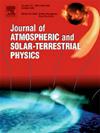Analytical model for the transit time of an interplanetary magnetic cloud
IF 1.8
4区 地球科学
Q3 GEOCHEMISTRY & GEOPHYSICS
Journal of Atmospheric and Solar-Terrestrial Physics
Pub Date : 2025-02-01
DOI:10.1016/j.jastp.2024.106416
引用次数: 0
Abstract
This paper presents an analytical model for the propagation of a toroidal interplanetary magnetic cloud from the vicinity of the Sun to Earth’s orbit. This model is applied to the May 12–15, 1997 event for calculations of cloud’s acceleration and velocity using a three forces approximation in driving the magnetic cloud’s dynamics: the diamagnetic push away from the stronger magnetic field region near the Sun, a drag force due to the ambient solar wind, and the Sun’s gravity pull. From the minimization of the difference between the calculated versus observed transit time of the magnetic cloud, we determine free parameters of our model and identify the solar source on May 12 at 5:03 UT. In situ measurements near Earth’s orbit done before May 12 set the values of the ambient interplanetary magnetic field, as well as of the ambient solar wind through which the magnetic cloud traveled. The observed temperature and density inside the magnetic cloud at Earth’s orbit determine the corresponding inner values during the magnetic cloud’s propagation. The coefficient of the drag force is one of free parameters in the model.
行星际磁云穿越时间的解析模型
本文提出了环面行星际磁云从太阳附近向地球轨道传播的解析模型。该模型应用于1997年5月12日至15日的事件,使用驱动磁云动力学的三种力近似来计算云的加速度和速度:远离太阳附近强磁场区域的反磁推力,由周围太阳风引起的阻力,以及太阳的引力。从计算值与观测值之间的最小差异出发,我们确定了模型的自由参数,并确定了5月12日5:03 UT的太阳源。在5月12日之前,在地球轨道附近进行的现场测量确定了环境行星际磁场的值,以及磁场云所经过的环境太阳风的值。在地球轨道上观测到的磁云内部的温度和密度决定了磁云传播过程中相应的内部值。阻力系数是模型中的自由参数之一。
本文章由计算机程序翻译,如有差异,请以英文原文为准。
求助全文
约1分钟内获得全文
求助全文
来源期刊

Journal of Atmospheric and Solar-Terrestrial Physics
地学-地球化学与地球物理
CiteScore
4.10
自引率
5.30%
发文量
95
审稿时长
6 months
期刊介绍:
The Journal of Atmospheric and Solar-Terrestrial Physics (JASTP) is an international journal concerned with the inter-disciplinary science of the Earth''s atmospheric and space environment, especially the highly varied and highly variable physical phenomena that occur in this natural laboratory and the processes that couple them.
The journal covers the physical processes operating in the troposphere, stratosphere, mesosphere, thermosphere, ionosphere, magnetosphere, the Sun, interplanetary medium, and heliosphere. Phenomena occurring in other "spheres", solar influences on climate, and supporting laboratory measurements are also considered. The journal deals especially with the coupling between the different regions.
Solar flares, coronal mass ejections, and other energetic events on the Sun create interesting and important perturbations in the near-Earth space environment. The physics of such "space weather" is central to the Journal of Atmospheric and Solar-Terrestrial Physics and the journal welcomes papers that lead in the direction of a predictive understanding of the coupled system. Regarding the upper atmosphere, the subjects of aeronomy, geomagnetism and geoelectricity, auroral phenomena, radio wave propagation, and plasma instabilities, are examples within the broad field of solar-terrestrial physics which emphasise the energy exchange between the solar wind, the magnetospheric and ionospheric plasmas, and the neutral gas. In the lower atmosphere, topics covered range from mesoscale to global scale dynamics, to atmospheric electricity, lightning and its effects, and to anthropogenic changes.
 求助内容:
求助内容: 应助结果提醒方式:
应助结果提醒方式:


